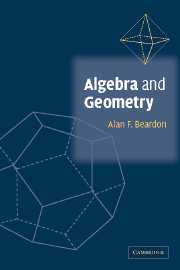Book contents
- Frontmatter
- Contents
- Preface
- 1 Groups and permutations
- 2 The real numbers
- 3 The complex plane
- 4 Vectors in three-dimensional space
- 5 Spherical geometry
- 6 Quaternions and isometries
- 7 Vector spaces
- 8 Linear equations
- 9 Matrices
- 10 Eigenvectors
- 11 Linear maps of Euclidean space
- 12 Groups
- 13 Möbius transformations
- 14 Group actions
- 15 Hyperbolic geometry
- Index
2 - The real numbers
Published online by Cambridge University Press: 05 September 2012
- Frontmatter
- Contents
- Preface
- 1 Groups and permutations
- 2 The real numbers
- 3 The complex plane
- 4 Vectors in three-dimensional space
- 5 Spherical geometry
- 6 Quaternions and isometries
- 7 Vector spaces
- 8 Linear equations
- 9 Matrices
- 10 Eigenvectors
- 11 Linear maps of Euclidean space
- 12 Groups
- 13 Möbius transformations
- 14 Group actions
- 15 Hyperbolic geometry
- Index
Summary
The integers
This chapter contains a brief review of the algebraic properties of the real numbers. As we usually think of the real numbers as the coordinates of points on a straight line we often refer to the set ℝ of real numbers as the real line. The set ℝ carries (and is characterized by) three important structures, namely an algebraic structure (addition, subtraction, multiplication and division), an order (positive numbers, negative numbers and zero), and the least upper bound property (or its equivalent). We shall take the existence of real numbers, and many of their properties (in particular, their order, and the existence of the n-th root of a positive number) for granted, and we concentrate on their algebraic properties. The rest of this section is devoted to a discussion of the set ℤ of integers. We review the algebraic structure of ℝ (using groups) in Section 2.2, and we introduce the idea of a field (an algebraic structure that has much in common with ℝ) in Section 2.3. In Section 2.4 we discuss modular arithmetic.
We now discuss the set ℕ = {1, 2, 3, …} of natural numbers, and the the set ℤ = {…, −2, −1, 0, 1, 2, …} of integers. One of the most basic facts about the integers is the
The Well-Ordering PrincipleAny non-empty subset of ℕ has a smallest member.
- Type
- Chapter
- Information
- Algebra and Geometry , pp. 22 - 30Publisher: Cambridge University PressPrint publication year: 2005



